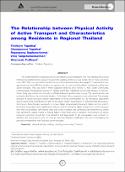บทคัดย่อ
ประโยชน์ทางสุขภาพจากกิจกรรมทางกายสัมพันธ์กับการเดิน การใช้จักรยาน และการใช้ขนส่งสาธารณะ สถาบันการเดินและการจักรยานไทยได้ส่งเสริมการเดินและการใช้จักรยานในชีวิตประจำวันในหลายจังหวัดตั้งแต่ ปี พ.ศ. 2560 การศึกษานี้ มีวัตถุประสงค์เพื่อค้นหาความสัมพันธ์ระหว่างลักษณะพื้นฐานทางประชากรและสังคมของประชาชน (เพศ อายุ ดัชนีมวลกาย ระดับการศึกษา อาชีพ และรายได้) กับกิจกรรมทางกายจากการเดินทางของประชาชนใน 3 ชุมชน คือ 1) ชุมชนสมเด็จพระเจ้าตากสิน อ.บางคล้า จ.ฉะเชิงเทรา 2) ชุมชนสุขสบายใจ อ.เมือง จ.กาฬสินธุ์ และ 3) ชุมชนบ้านธาตุสบแวน อ.เชียงคำ จ.พะเยา ระเบียบวิธีวิจัยเป็นการศึกษาภาคตัดขวาง ใช้แบบสอบถามในการสำรวจด้วยการสุ่มกระจายในชุมชนโดยผู้นำชุมชน วิเคราะห์ข้อมูลด้วยการวิเคราะห์ถดถอยปัวซอง (multivariate Poisson regression) ผลการศึกษาพบว่า พลังงานเฉลี่ยจากกิจกรรมทางกายในการเดินทางที่ 180 metabolic equivalent task-นาที/สัปดาห์ เป็นสัดส่วนร้อยละ 30 ของข้อแนะนำการมีกิจกรรมทางกายขององค์การอนามัยโลก เพศหญิง การมีน้ำหนักเกินหรืออ้วน การมีระดับการศึกษาและรายได้ที่สูง การทำงานในสำนักงาน ลดโอกาสการใช้พลังงานจากกิจกรรมทางกายในการเดินทาง ในขณะที่การมีอายุมากกว่า เพิ่มโอกาสการใช้พลังงานจากกิจกรรมทางกายในการเดินทาง มาตรการส่งเสริมการเดิน การใช้จักรยาน และการใช้ขนส่งสาธารณะ ควรออกแบบให้น่าดึงดูดและเหมาะสมกับลักษณะพื้นฐานทางประชากรและสังคม รวมถึงบริบทพื้นที่ นอกจากนี้ นโยบายส่งเสริมไม่ควรเน้นเฉพาะระดับบุคคล แต่ควรปรับสภาพแวดล้อมทางกายภาพให้เหมาะกับการมีกิจกรรมทางกายในการเดินทางด้วย
บทคัดย่อ
The health benefits of physical activity are linked to active transport. The Thai Walking and Cycling Institute has implemented a project to promote walking and bicycle use in daily life in many provinces since 2017. This study aimed to identify the association between local demographic characteristics (sex, age, body mass index (BMI), education, occupation, and income), and the effects of physical activity from active transport. This was done in three purposive selected sites namely, 1) King Taksin Community, Chachoengsao, 2) Suksabaijai Community, Kalasin, and 3) Ban Thatsobvan Community, Phayao. A cross-sectional study was carried out through a self-administered questionnaire survey. The questionnaire was randomly distributed via community leaders. Multivariate Poisson regression was performed. The average amount of active transport energy expenditure in three communities at 180 metabolic equivalent task-minutes/week contributed to 30% of the World Health Organization’s recommended physical activity levels. Being female, overweight or obese, higher educational attainment, higher income, and office-based employee had a significantly reduced chance of having higher energy from active transport than their counterparts. While being older and living in optimal size community and near the city center had significantly raised chance of having higher energy from active transport. Interventions for active transport promotion should be more attractive and appropriate to all demographics and contexts. In addition, the policy should aim not only at individual lifestyle modification but also at re-shaping the physical environments that facilitate active transport.


